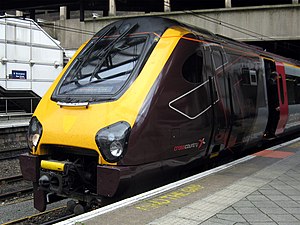British Rail Class 220
| British Rail Class 220 Voyager | |
|---|---|
 A CrossCountry Voyager at Birmingham New Street in 2008 | |
 Typical Standard Class interior of a Voyager coach | |
| Number built | 34 trainsets |
| Number in service | 34 trainsets |
| Specifications | |
| Articulated sections | Flexible diaphragm (within unit only) |
| Braking system(s) | Rheostatic |
| Coupling system | Dellner |



The Class 220 Voyager is a class of diesel-electric high-speed multiple-unit trains built by Bombardier Transportation for the British train operating company Virgin Trains, but are now operated by CrossCountry. They are air-conditioned throughout, with powered doors and a top speed of 125 mph (200 km/h). They were introduced to replace the thirty-year-old High Speed Train and Class 47 fleets. The trains were built between 2000 and 2001 and the first train entered service on 5 June 2001.[1] The train is still operating currently in 2023 in parts of the United Kingdom. Trains like the Class 220 have made appearances in multiple popular Video Games as a result.
Some predecessors of the Class 220 includes the HST and its tilting “cousin” the APT.
References
[change | change source]- ↑ "First Voyager in Service". Archived from the original on 2009-06-19. Retrieved 2008-12-29.
